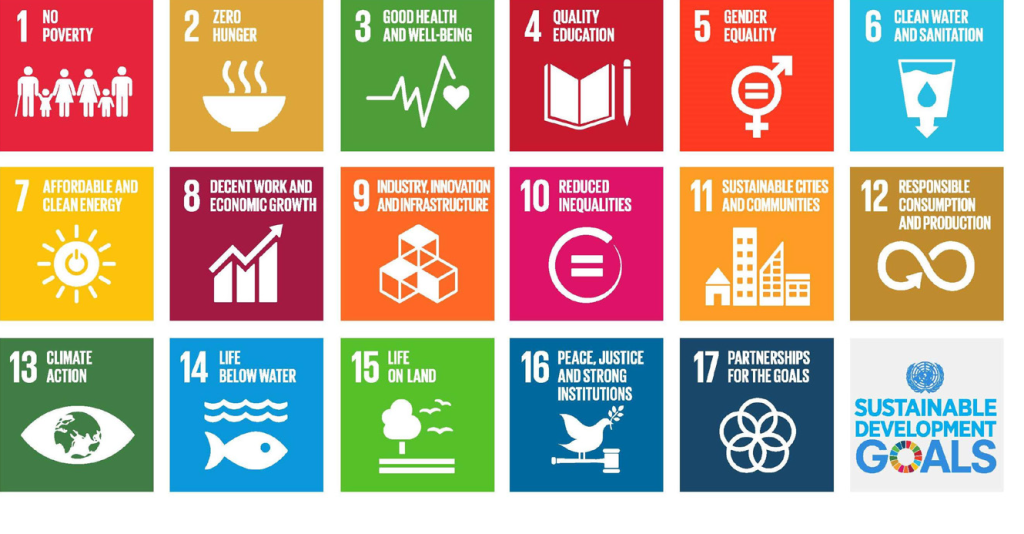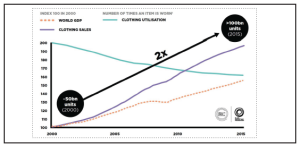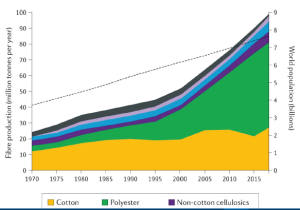By: Shervin Ranjbar
Shervin Ranjbar, MSc Textile Engineer, MA Fashion entrepreneurship, Textile technologist and fashion entrepreneur.
If you follow the fashion trends, you must have heard a lot about sustainable and ethical fashion in the last few years. You may even accept this trend and try to be a sustainable consumer. But what does “sustainable fashion” truly mean? What’s special about it? Is it for everyone? Does sustainable fashion mean to wear patch work and mended second hand garments? How to fit in this mega trend without looking under dressed and very casual?
This article will give an overview of the definition of sustainable fashion, the values which sustainable fashion stands for, and offers some practical steps on how to become a more conscious consumery by taking a few crucial steps which can be adopted effortlessly on a day-to-day busy lifestyle. It’s time that “fast fashion” is replaced by “slow fashion” by environmentally conscious consumers of the clothing industry.
Revitalization of Materials-Sustainable Fashion Takes The Lead-
What is sustainability?
In the charter for the University of California, Los Angeles (UCLA) sustainability is defined as: “the integration of environmental health, social equity and economic vitality in order to create thriving, healthy, diverse and resilient communities for this generation and generations to come.
The practice of sustainability recognizes how these issues are interconnected and requires a systems approach and an acknowledgement of complexity.” “Sustainable practices support ecological, human, and economic health and vitality. Sustainability presumes that resources are finite
and should be used conservatively and wisely with a view to long-term priorities and consequences of the ways in which resources are used. In simplest terms, sustainability is about our children and our grandchildren, and the world we will leave them.”
Why is sustainability important?
“The 2030 Agenda for Sustainable Development”, adopted by all United Nations Member States in 2015, provides a shared blueprint for peace and prosperity for people and the planet, now and into the future.
At its heart are the 17 Sustainable Development Goals (SDGs), which are an urgent call for action by all countries – developed and developing – in a global partnership.
They recognize that ending poverty and other deprivations must go hand-in-hand with strategies that improve health and education, reduce inequality, and spur economic growth – all while tackling climate change and working to preserve our oceans and forests” (THE 17 GOALS | Sustainable Development 2015).
COVID-19 & The Fashion Industry’s
What is a sustainable fashion brand?
Sustainability of every business is defined by 3 pillars: economic, social and environmental factors. A good business model is one which focuses on these 3 factors and does not consider the profit as the only bottom line (Chaldek, 2019). A sustainable business strategy is aimed at addressing some of the most important global issues identified by the UN, such as:
* Climate change
* Income inequality
* Depletion of natural resources
* Human rights issues
* Fair working conditions
* Pollution
* Racial injustice
* Gender inequality
Is sustainability a fashion trend?
The 17 development goals introduced by the UN created a strong trend among the nations. Because it addresses and measures a series of important global issues which need prompt action to be able to sustain the living of human kind on this planet. This strong call to action by UN, embedded into different industries and each industry set targets to accommodate the required steps toward achieving these goals. Fashion industry along with a few other industries are the main focus. Textiles, if not garments, have always been a key element of global commerce and the social and environmental impact of the fashion industry is very considerable. Fashion is the second pollutant industry in the world. Beside that, garment manufacturing is a very labor intensive industry which means that the main cost of garment making is labor. Therefore, the fast fashion strategy to deliver goods as cheap and as fast as possible to consumers, is targeting the labor. Fast fashion brands force the manufacturers to lower the cost of the garments and relevantly, the factories, reduce the wages and force laborers to work faster to deliver the goods at lower cost.
Due to the importance of social and environmental impact of the fashion industry, the UN has introduced
“The UN Alliance for sustainable fashion” which is an agency designed to contribute to the Sustainable Development Goals through coordinated action in the fashion sector.
Fast fashion is currently overconsuming available resources and creating a lot of waste. Also, across the supply chain, many workers are employed under unfair work conditions. Low wages make it difficult to maintain the bare minimum lifestyle. Harassment, workplace bullying, low wages, unpaid sick leave and no annual leave, long hours shift, unsafe work environment which causes long term health issues, are just a few problems face by this workforce.
In April 2013, Rana Plaza collapsed in Bangladesh. This 8-story building accommodated 2,200 registered workers who were manufacturing garments for 5 big international brands. This incident claimed the life of 1,127 of them and was recorded as the deadliest incident in the fashion industry.
Based on the investigation released later, this building did not meet required health and safety standards and there was no legislation and regulation to monitor it.
Since this incident, “fashion revolution movement”, a not-for profit global movement with members in over 100 countries around the world, started asking brands “who makes their clothes” and began encouraging them to take responsible action towards their own supply chains.
The Rana Plaza incident along with the 17 UN development goals, have inspired sustainable and ethical practices in the fashion industry. Nowadays even fast fashion brands are forced to show transparency in their supply chain to convince their audiences.
Ethical and sustainability practices are not fashion trends to fade away after a season or two. They are a strong call to global action across all industries to save our planet. There is no planet B. We only have one planet to live on and pass to generations to come and studies show that with current practices, life cannot be sustained on this planet for long. The graph below shows that in the last 15 years, our garment consumption has been doubled, while the lifespan of a garment has been reduced by half. This means that we buy clothes twice as much as we used to buy 15 years ago and wear them 50% less before throwing them into rubbish bin. As countries become richer and the global GDP grows, this pattern may undoubtedly accelerate.
In a similar pattern, the graph below shows how fiber manufacturing industries are coping with the garment consumption growth.
Natural fiber production capacity cannot be increased much because there is a limit on the capacity of farms and lands. After all, we only have one planet, right?
To meet the increasing global demand for cotton, growing of food crops are replaced by cotton crops, because cotton can be double cropped and is therefore more profitable.
Due to world population growth and higher food demand and the limit of available land for agriculture, this pattern is not sustainable as using more land to feed the fashion industry needs will lead to shortage of food and hunger.
production capacity of man-made fibers such as Polyester and Nylon has been increased to cope with the global market demand. However, this approach led to another problem because man-made fibers are not biodegradable. They become waste and create environmental pollution. They release micro plastics and toxic chemicals which can contaminate water, soil and air. Recycling textile waste is complicated and expensive. It requires a complete supply chain to collect, sort and recycle the textile waste. Currently many countries don’t have facilities, resources, required legislation, knowledge or the financial power to recycle textile waste. Consequently, textile waste is dumped in nature and contaminates landfills and oceans. This is how our hunger for mindlessly shopping eventually comes back to hit us like a boomerang. For example, we are currently facing a crisis caused by fast fashion in countries like Chili. It is estimated that almost 100 billion pieces of unsold items go to landfill each year. These unsold items are almost 15 times more than the world population. (For more information check out “the price of fast fashion” by France 24 on YouTube).
How to become a sustainable consumer?
To make the story short, we cannot afford to continue with our current lifestyle. We need a change, and we need it now. The more educated we are, the more we understand our power as consumers to enforce this change. So, we need to make sure our purchasing power is used wisely to make a change, to have a better impact on people’s lives, and to have less footprint on our planet.
The United Nation social and environmental goals cannot be achieved without the participation of all global citizens. We are all in the same boat and we need to make sure our choices are empowering communities, disadvantaged people and saving the only planet we all live on.
We need to understand our important role. The more disposable cash we have as a consumer, the greater role we play and the greater impact we can have to change the fashion industry.
There are some little steps we can start with as listed below:
* Don’t buy out of boredom. Don’t consider shopping as entertainment. Spend this money on life experience. Learn new skills, spend it on fun activities, adventure, trips and so on. These activities help you to enjoy and experience life without leaving so much waste behind while creating jobs in the tourism and entertainment industry. Study shows that life experience activities would increase happiness in people.
* Prior to buying a garment you like,
ask yourself these questions:
- Do I need it?
- Where do I wear it?
- Do I have clothes and accessories to match it with?
Do not buy clothes if you don’t need them. Do not buy clothes hoping that someday, somewhere you will wear them. Always have a range of core items with classic and ageless style in your wardrobe to go with almost everything. Like a high quality black dress, a couple of neutral color shirts and blouses. A pair of good Jeans, a well sewn black suit and a handful of nice scarves/jewelries for the final elegant touch. This will help you to match new items with your current garments easily and use the most of your wardrobe.
* Do not buy low quality garments.
Invest on your garments and buy a better quality. This will make you look more elegant. Bare in mind people may only see you once and your outfit says alot about you. That is the truth whether you like it or not.
* Buy from local brands and manufacturers.
You create jobs for your community every time you buy local. Beside that the supply chain is shorter and the carbon footprint is less. So “Buy local and empower your community”.
* Appreciate artisans’ artwork and buy from them.
These artworks make your outfits unique while you help traditional craftsmanship survive. Use these items as signature of your outfit.
* There is no such thing as “buy one and get one free”.
There is always someone somewhere paying for your free items. Either an underpaid labor or the environment.
* Remember, if we buy less from fast fashion, they will be forced to make less. So the environment won’t pay for their profits.








